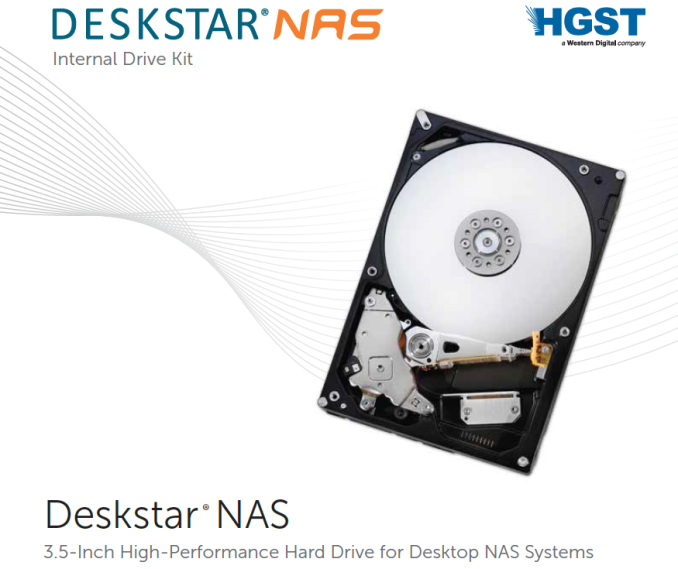HGST Deskstar NAS 4 TB Review
by Ganesh T S on November 22, 2014 2:00 PM ESTConcluding Remarks
The HGST Deskstar NAS 4 TB has been evaluated for both NAS and DAS applications and the numbers put up for comparison against other 4 TB drives targeting this market segment. As expected, there is no 'one size fits all' model in this area. The various hard drives in the comparison lot were launched targeting different markets and their resulting performance varies accordingly.
Thanks to the 7200 RPM speeds, the HGST Deskstar NAS does manage to acquit itself well in the overall performance category. Though it is not the absolute best, it performs admirably well in the random access patterns segment of the multi-client evaluation.
The HGST Deskstar NAS doesn't deliver the lowest power consumption. Those were recorded, as expected, with the 5400/5900 RPM drives: the WD Reds, Seagate NAS HDDs and the Seagate Terascale units. However, the Deskstar NAS manages to almost win the efficiency category - thanks to the great balance between speed and power consumption. The energy consumption for the resync process was bettered only by the Seagate Enterprise Capacity v4 (which comes with a much higher price tag).
In terms of pricing, the HGST Deskstar NAS wins comfortably. It is, by far, the most price effective 7200 rpm 4 TB drive in this market segment. The closest competitor is the WD Red Pro, which retails for at least $50 more. At $185, the Deskstar NAS is beaten in price only by the WD Red and the Seagate NAS HDD (both of which come in around the $170 range).
There are plenty of options for NAS users looking to stock up their NAS units with high capacity drives. Though not at the bleeding edge of capacity, today's 4TB drives offer a good mix of pricing, performance, and capacity. For the cautious buyer, 4 TB drives offer an alternative to the potential risk in going the new technology route with 6 TB drives. With the right data in hand, it's easy enough to find the best fit by taking into consideration the expected workload and desired price points.The overall verdict is that the HGST Deskstar NAS is a cost-effective solution for scenarios where non-sequential workloads with simultaneous multi-client accesses are common











39 Comments
View All Comments
josue16 - Monday, November 24, 2014 - link
So, which of the 4 TB drives are more reliable? Are there companies that report HDD reliability?jota83 - Monday, November 24, 2014 - link
Not really.... just MTBF and unrecoverable errors rate. The one that is collecting data since its foundation is, as stated multiple times along the comments, backblaze. They are collecting a lot of data and reporting those to the community in a periodic basis. They have surveyed several branched, and they have a pool of more than 30k disks and growing. Even if they are a very respectable firm, their strategy to offer unlimited backup for a very low feed lead them to look for a design that while being robust is very cheap... hence the NAS disks "consumer" grade. I find fascinating what they have achieved in no time! You might want to check at their blog, with plenty of nice information. Cheers!Jeff Biscuits - Tuesday, December 9, 2014 - link
Anyone happen to know when the 5TB and 6TB versions are due to hit UK? They're listed on the HGST website but when I look for them for sale I only find them available on US retailersalecweder - Wednesday, February 4, 2015 - link
The biggest issue with RAID are the unrecoverable read errors.If you loose the drive, the RAID has to read 100% of the remaining drives even if there is no data on portions of the drive. If you get an error on rebuild, the entire array will die.
http://www.enterprisestorageforum.com/storage-mana...
A UER on SATA of 1 in 10^14 bits read means a read failure every 12.5 terabytes. A 500
GB drive has 0.04E14 bits, so in the worst case rebuilding that drive in a five-drive
RAID-5 group means transferring 0.20E14 bits. This means there is a 20% probability
of an unrecoverable error during the rebuild. Enterprise class disks are less prone to this problem:
http://www.lucidti.com/zfs-checksums-add-reliabili...
hansmuff - Thursday, March 5, 2015 - link
You can circumvent these issues by using ZFS. Put that on a box with ECC RAM and back it up online, and you've got a pretty reliable solution.willis936 - Saturday, May 9, 2015 - link
I've done receiver testing on sata drives before and I can tell you while drives are only tested to 10^-14 BER with 95% confidence that if the channel is clean and both the host and hard drive have good phys and you don't do something like put your phone on the hard drive then you won't see a single phy related error until something fails. A URE refers to a drive failure to read a bit. It's unrelated to sata as you implied.comomolo - Tuesday, May 17, 2016 - link
Is it really worth it to get these NAS drives vs their regular versions? My use case is a home NAS, Linux software RAID or ZFS (no HBA). Will I miss anything by not using the NAS version of the drive? The difference in price is not trivial in Spain (some 20% more for the NAS model).Thanks for any help.
Hisated936 - Saturday, June 9, 2018 - link
Comcast won't send you your neglected password https://xfinitylogin.us/ On top of the homepage, you must see the Sign in link, Click it to get redirected.ffarzan - Tuesday, June 29, 2021 - link
I bumped into your web site checking spec. on Hitachi 4TB, and saw your comparison chart , extremely useful,do you have any such comparison table for Seagate, or by Model No. across any given brand, and manufacturer ?? , Thanks